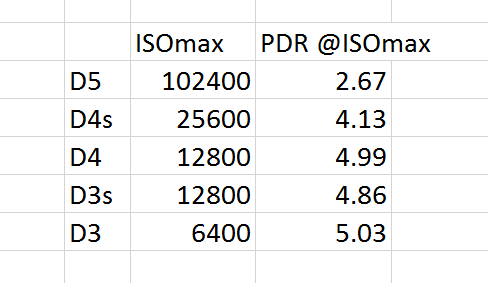This is part of a series of posts about the Nikon D5. The series starts here:
Do you remember the movie This is Spinal Tap? In one memorable scene, a band member rhapsodizes over a amp whose knobs go to eleven, instead of the usual ten, as evidence that the amp is more powerful than most. The phrase “up to eleven” has even shown up in dictionaries.
That’s just silly, right? That kind of magical thinking has no place in camera purchasing. We’re too smart for that. We’d no more buy a camera based on some meaningless number than we’d buy a car because the speedometer numbers went to some insane speed.
Maybe not all of us.
More than a few people have remarked that it is significant that Nikon make the maximum setting of its ISO control that merits a number ISO 102400, whereas its predecessor, the D4s, only had a knob that went to 25160.
Four times the number, gotta be four times as light sensitive, right?
Wrong.
There are very few rules for what a camera manufacturer can call the base ISO of the camera. It’s not like the days of film where there was a detailed procedure that limited development trickery to eke out a higher number than the chemists designed in there.
Near as I can tell, there are no rules at all on what a camera manufacturer can call the highest ISO setting on a camera. I’ll bet that, at the meeting where that number is determined, the engineers are politely shooed out of the room so that they don’t cramp the style of the product managers who are going to make that decision.
You’d think there would be some consistency within a given company, or, failing that, within a certain line of cameras. You’d be wrong.
Here’s an interesting table that I constructed this morning with the aid of Bill Claff’s excellent web site:
Here are the last five generations of Nikon’s flagship DSLR, with the maximum numeric ISO (No HI-1, or Hi-5 allowed) for each shown. Also shown is the Claff photographic dynamic range (PDR) for each camera at its ISOmax.
You can see that Nikon was pretty consistent when they decided what image quality they’d allow at the ISOmax for the D3, the D3s, and the D4. They let their standards slip a bit with the D4s.
For the D5, they abandoned any sense of their previous standards, and, in my opinion, any sense of shame. If the D5 had used D3, D3s, or D4 standards for ISOmax, it would be about 20000.

Good one, Jim.
Oh dear this is really disappointing.
Not of course that there’s such little quality at stratospheric ISO. If the breakthrough required to make that happen had occurred we would know. But that Nikon would be in the business of trying to manipulate photographers who aren’t technically savvy this way.
https://en.wikipedia.org/wiki/Up_to_eleven#/media/File:Spinal_Tap_-_Up_to_Eleven.jpg
Select the “Ideal FX” in that chart. Its 102400 PDR is just 2.82
Maybe its physics that has no shame, not Nikon.
What if you evaluate jpegs? From what I’ve seen, the noise reduction has improved much more dramatically than raw performance and that might be their reasoning for increasing the limit.
An interesting point. I don’t think I want to start looking at JPEGs, though. That’s a lot of work and I never use them.